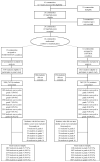Sustained decreases in risk exposure and youth problem behaviors after installation of the Communities That Care prevention system in a randomized trial
- PMID: 21969362
- PMCID: PMC4137869
- DOI: 10.1001/archpediatrics.2011.183
Sustained decreases in risk exposure and youth problem behaviors after installation of the Communities That Care prevention system in a randomized trial
Abstract
Objective: To test whether the Communities That Care (CTC) prevention system reduced levels of risk and adolescent problem behaviors community-wide 6 years after installation of CTC and 1 year after study-provided resources ended.
Design: A community randomized trial.
Setting: Twenty-four small towns in 7 states, matched within state, randomly assigned to control or intervention condition in 2003.
Participants: A panel of 4407 fifth-grade students was surveyed annually through 10th grade from 2004 to 2009.
Intervention: A coalition of community stakeholders received training and technical assistance to install CTC, used epidemiologic data to identify elevated risk factors and depressed protective factors in the community, and implemented programs to address their community's elevated risks from a menu of tested and effective programs for youths aged 10 to 14 years, their families, and schools.
Outcome measures: Levels of risk and incidence and prevalence of tobacco, alcohol, and other drug use; delinquency; and violent behavior by grade 10.
Results: Mean levels of targeted risks increased less rapidly between grades 5 and 10 in CTC than in control communities and were significantly lower in CTC than control communities in grade 10. The incidence of delinquent behavior, alcohol use, and cigarette use and the prevalence of current cigarette use and past-year delinquent and violent behavior were significantly lower in CTC than in control communities in grade 10.
Conclusions: Using the CTC system can produce enduring reductions in community-wide levels of risk factors and problem behaviors among adolescents beyond the years of supported implementation, potentially contributing to long-term public health benefits.
Trial registration: clinicaltrials.gov Identifier: NCT01088542.
Figures




References
-
- Mokdad AH, Marks JS, Stroup DF, Gerberding JL. Actual causes of death in the United States, 2000. JAMA. 2004;291(10):1238–1245. - PubMed
-
- Woolf SH. The big answer: rediscovering prevention at a time of crisis in health care. Harv Health Policy Rev. 2006;7(2):5–20.
-
- Specter A. Making youth violence prevention a national priority. Am J Prev Med. 2008;34(3, Suppl 1):S3–S4. - PubMed
-
- U.S. Department of Health and Human Services . Youth Violence: A Report of the Surgeon General. U.S. Department of Health and Human Services, Substance Abuse and Mental Health Services Administration, Center for Mental Health Services, National Institutes of Health, National Institute of Mental Health; Rockville, MD: 2001.
Publication types
MeSH terms
Associated data
Grants and funding
LinkOut - more resources
Full Text Sources
Medical
Miscellaneous

